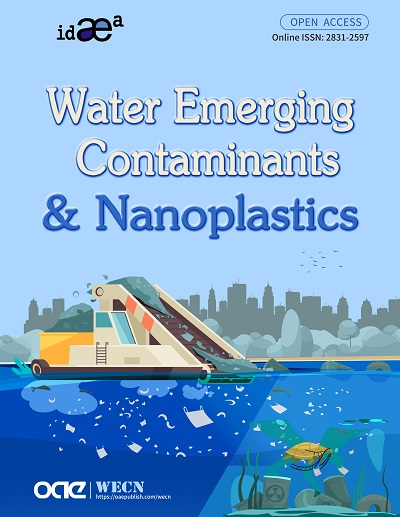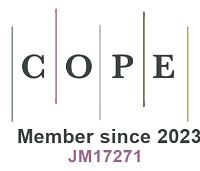Prediction of nanoplastics aggregation in wastewaters
Abstract
Discarded plastic wastes are slowly degrading into smaller parts, namely microplastics, that can be easily transported to oceans by water streams. In vast, salty, and sunny environments, they degrade even faster and are subject to come back in the water network used for drinking or industrial water in the form of nearly indetectable objects: nanoplastics. Once in busy buffers such as wastewaters, nanoplastics will tend to aggregate to form tertiary microplastics formed of single or multiple types of plastics and potentially host other materials ranging from organics and metals to bacteria and viruses. Their nature, random shape, and various size are at the origin of nuclei merging together or with other objects. Two particles at a close distance from each other can either attract or repulse themselves depending on their nature and constitution. At very short distances, Van der Waals forces are predominant and a measure of them is given by the so-called Hamaker constant. We propose to predict this aggregation by estimating the Hamaker’s constant.
Keywords
Microplastics (MPs) are plastic particles with a size between 1 µm-5 mm, and they are found worldwide in the environment. MPs appear in the atmosphere[1], natural water bodies[2], wastewaters[3], and soil[4]. MPs are categorized into primary and secondary: primary MPs are manufactured to micro size and usually have a regular shape, such as spherical. However, the majority of MPs in the environment are secondary, which result from the degradation of plastic items into smaller fragments by exposure to ultraviolet (UV) light and mechanical wear. Secondary MPs have different, mostly irregular forms, such as fiber, fragment, sponge, etc. Photonics-based methods, such as hyperspectral imaging[5,6], have been developed and tested to detect MPs in field measurement conditions. In addition to the simple detection, photonics allows for the sorting and monitoring of possibly aggregated MPs directly from diluted small-scale wastewater samples through ultra-high-definition imaging of MPs in the micrometer range[7]. Big-scale oceanic floating microplastics and the role of surfactants on wave surface roughness have been investigated using data from NASA Cyclone Global Navigation Satellite Systems[8]. Much attention has been paid to MPs interaction and transport with other types of materials, such as pharmaceuticals and personal care products[9], aggregation with clay minerals[10], interfacial interactions between plastic particles in plastics flotation[11], microbubble MP interactions in batch air flow[12].
MPs can further fragment into environmental nanoplastics (NPs), which are any plastic particles having a size between 1-1000 nm[13]. In this manuscript, we consider NPs as items with a size smaller than 100 nm, on which Van der Waals forces have the strongest influence. In the field of investigation of aggregation of NPs, most of the published articles deal with commercial spherical NPs in well-controlled laboratory conditions. Furthermore, such investigations typically involve homogenous aggregation, i.e., NPs that present the same plastic type. In real aquatic environments, the situation is more complex. There can be NPs presenting different plastic types and have irregular shapes and surface roughness that are different from spherical shape Latex[14]. In addition, in aquatic environments, there can be other irregular-shaped inorganic and organic particles that can interact with the NPs. Organic particles, such as lignin, cellulose, bacteria, viruses etc., and inorganic particles, such as clay minerals or metal particles, contribute to the complexity of water, and one faces the problem of multi-body interactions. This is the reality regarding both industrial and municipal wastewaters, namely complex thermodynamical systems with varying conditions and playing with properties of colloids and suspensions.
Different sectors of process industries have to deal with a lot of contaminants, including MPs[15] and NPs, in wastewater, e.g., in the water-intensive pulp and paper industry[16], and in the semiconductor industry[17]. Wastewater is a complex medium, often making difficult an optical analysis. In industrial wastewaters, there can be nano-size contaminants not belonging to NPs but can be metals, semiconductors, or insulators. In addition to solid nano-and microparticles and bigger units in wastewater, some materials are dissolved in the water and give color to water. For example, lignin gives yellowish/brownish color to the wastewater in paper mills. It is a big problem to give a general model to predict heterogeneous aggregation of NPs in complex wastewater systems under different conditions such as pH, ionic strength, laminar/turbulent flow, heat convection (e.g., condensation water from nuclear plants to natural water bodies) and overall physical or chemical conditions of the wastewater. However, there is one interaction that is always present, namely van der Waals forces that have importance in the aggregation processes of tiny items, such as NPs. Now nanostructures typically have material properties that are different from the same bulk medium. Taking the case of a NP originating from a colored macroscopic plastic, one can easily admit that while the size of such a NP becomes small enough, this NP will be transparent in clear water. In colored wastewater, such an item with a size smaller than the wavelength will certainly be hidden and obscured within and by the probably changing color of the medium. The optimum case for observation is that such NPs form an aggregate, big enough to be detected. Then it would be possible to study the morphology of the aggregate (potentially a fractal) and identify its constituents and properties, also including its color.
There is a need and demand for in situ and continuous detection of possible NPs in natural water bodies and especially in the complex, and therefore problematic, case of wastewaters. The development of photonics-based sensor solutions is a plausible alternative to robust standard chemical analysis methods, especially for the imaging and characterization of aggregates.
We propose here a method based on Lifshitz theory to estimate the affinity between two nanoplastics and therefore their possible aggregation. The concept is illustrated in Figure 1.
Figure 1. Illustration of the concept: From known/measured spectral data acquired from macroplastics and environments, we extract the Hamaker’s constant to predict the aggregation of nanoplastics.
The possibility of heterogeneous interaction of nanoparticles that have different material properties can be predicted from their macroscopic properties using a concept based on their complex permittivity. This intrinsic material property can be used for the prediction of both homogenous and heterogeneous aggregation of both regular- and irregular-shaped nanoparticles, including NPs. The crucial tool in the prediction of nanoparticle aggregation is the so-called Hamaker’s constant, which can be estimated from measured spectral data of macroscopic materials through calculations based on the Lifshitz theory[18]. Let us consider two planar materials 1 and 2 surrounded in a medium 3 (wastewater in our case). In the Lifshitz theory, the Hamaker constant A132 quantifying the interaction between materials 1 and 2 can be calculated with the aid of the angular frequency-dependent relative complex permittivity (a complex number) characterizing the materials in a unique manner if the wavelength range of observation is large enough. The calculation is based on an expression of the relative permittivity that is given at a purely imaginary angular frequency variable of the electromagnetic field as follows[18]:
Where h is the Planck’s constant, i is the imaginary unit, and ξ is the so-called Matsubara frequency and it is related to the absolute temperature of the system. The real-valued permittivity εj , with the index representing the three materials j = 1, 2, 3, at imaginary frequency can be obtained from the following integral[18]:
In Eq. (2), the imaginary part of the complex permittivity, ℑ{εj (↑τ)} is usually obtained by measurements with different devices depending on the spectral range of investigation. For spectral information ranging from visible to infrared, an ellipsometer can be used to measure the complex refractive index, N(ω) = n (ω) + ik(ω) of a medium, which in turn can be used to get the imaginary permittivity ℑ{εj (ω)} = 2n(ω) k(ω). Since it always holds for bulk media that ℑ{εj (ω)} > 0, then left hand-side of Eq. (2) is always positive. The inherent problem raised by Eq. (2) is the need for data in the whole semi-infinite frequency axis for an exact determination of A132. Unfortunately, such data are not available for plastics or water. Therefore, models such as the oscillator model have been exploited to predict the complex relative permittivity of materials, such as that of pure water[19]. For rigorous use of Eq. (1) to predict the strength of heterogeneous or homogeneous aggregation of the particles, knowledge of the complex permittivity of materials 1 and 2 is also required. This is an issue in the case of wastewater. As we have already mentioned, dissolved organic materials in water contribute to the complex permittivity of the host medium, i.e., the wastewater, which may vary with time depending on the dissolved constituents. Furthermore, the amount of different spectral devices and their compatibility needed makes the determination of the complex permittivity of a broad extended spectral range currently nearly impossible. Recent progress in terahertz (THz) technology has improved our knowledge of spectral properties of plastics in the THz-gap[20], which helps in extending the spectral information for the calculation of Hamaker’s constant of polymers in aquatic environments, and hence improved information also on the strength of aggregation processes. Fortunately, one can relax the complexity of wastewater and contaminants and predict qualitatively aggregation processes using the integrand of Eq. (1), namely
This real-valued function f defines the sign of the Hamaker’s constant, which in turn indicates either attractive or repulsive van der Waals forces between nanoparticles, nano-and microparticles, but also bigger objects. It is evident from Eq. (1) and (3) that if materials 1 and 3 are of the same type, the sign of the Hamaker’s constant is always positive, and it means homogenous attraction of such alike nanoparticles, hence including similar NPs having regular or irregular morphology. Furthermore, if ε1 (iξ) and ε2 (iξ) > ε3 (iξ), or ε1 (iξ) and ε2 (iξ) < ε3 (iξ), the integrand is a positive function and different material type nanoparticles will experience heterogeneous aggregation, including NPs of different material types. Although there are differences in plastics, they still belong to insulators and have some common material properties. Hence aggregation between different plastic types, e.g., PET and PS, is probable and demonstrated in plastics flotation for microbeads[11]. In the case that this special-type imaginary argument permittivity function of water is between such functions of materials 1 and 2, repulsive van der Walls forces are in action and hence yield negative Hamaker’s constant. An interesting case is an air bubble since one can approximate that for an air bubble, say it would be medium 1, and it holds approximately that ε1 (iξ) = 1. This means that in the case of interaction of NPs with such air bubbles in the intervening water, the van der Waals forces would be repulsive[21]. However, hydrophobic plastics can capture moving objects, such as air bubbles, as was demonstrated for PET MP in[7].
If one knew the full spectral data of all possible nano- or microparticles that can appear in water, it would be possible to predict the relative strengths of heterogeneous aggregation of systems, such as viruses and NPs, solid lignin and NPs, heavy metals and NPs, etc. In the case of heavy metals that are nanoparticles, their complex permittivity depends on the size of the particle, and this has been studied in the tuning of the Hamaker’s constant by the radius of metal nanosphere[22], and meaning that the strength of heterogeneous aggregation in the case of NPs and heavy metal nanospheres depends on the radius of the metallic nanosphere. Irregular metallic nanostructures would obey different, so far, unknown morphology-dependent complex permittivity, but once the inequalities for permittivity given above are valid, they will qualitatively aggregate with NPs. Similar arguments about the permittivity also hold for semiconductor quantum dots (QDs) and their aggregation with NPs, and organic materials[23].
From the above discussion, one can clearly see the need for effective spectroscopy tools in order to measure the broadest spectrum of an analyte and actually of a particle in water. Despite many research works, this remains a challenge for in-situ measurement since a combination of microscopy, spectroscopy and chemometrics would be needed to assess the data related to the spectral response of an aggregate. This requires then sampling and careful preparation as already demonstrated in the chemistry in the case of colloids[23].
In this paper, we emphasize the possibility of predicting the trend of heterogeneous aggregation of different types of plastic NPs, and that the method holds to irregular-shaped NPs. Such a heterogeneous aggregate structure would have an effect both on the transportation of NP aggregates in aquatic environments and improved optical detection of an aggregate instead of the complexity of trying to image or identify a single NP. However, aggregates of different nanoplastic types but with similar and overlapping fingerprints over the studied spectral range may lead to misidentification. Aging of NPs may change their complex permittivity that depends on the temperature of the wastewater. Hence, calculations based on Eqs. (1) and (2) would always require spectral measurements at temperatures corresponding to the temperature of the wastewater, and preferably conducting with aged plastic samples in spectral measurements. Qualitatively NPs tend to aggregate when van der Waals forces come into play, and this is already important information regarding future sensor developments to monitor wastewater quality. Dissolved organic materials contribute to the imaginary permittivity, especially in the infrared, but in wastewaters, the change is not expected to be dramatic in the whole semi-infinite frequency range in respect of the intrinsic complex permittivity of pure water. Aging of plastics may cause changes in the position and height of spectral features, but one is not expecting drastic variations.
The methods currently developed for the in-line or off-line detection of micro-plastics in wastewaters or, more generally, in industrial water allow for knowing what type of plastics is present and the chemical analysis of the matrix, i.e., the water itself, provides an understanding of the environment. Combined with the theory we developed in this article, one is then able to give a better ground on the exploitation of hyperspectral measurement, often lacking resolution, or high-resolution imaging, lacking spectral information. Such knowledge is of utmost importance in the quality control of rejected waters that are submitted to more and more strict regulations[24]. Nanoplastics and aggregates of nanoplastics are now becoming the new challenge in this field and they must be understood before being detected and removed.
DECLARATIONS
Authors’ contributionsWrote and reviewed the manuscript: Peiponen KE, Roussey M
The authors contributed equally to the article.
Availability of data and materialsNot applicable.
Financial support and sponsorshipThis work was supported by the Academy of Finland Flagship programme PREIN (decision 320166), the Business Finland project CEIWA (No. 541/31/2021), and the Project IBAIA, funding from the European Union’s Horizon Europe Framework Programme (No. 101092723).
Conflicts of interestAll authors declared that there are no conflicts of interest.
Ethical approval and consent to participateNot applicable.
Consent for publicationNot applicable.
Copyright© The Author(s) 2023.
REFERENCES
1. Zhang Y, Kang S, Allen S, Allen D, Gao T, Sillanpää M. Atmospheric microplastics: a review on current status and perspectives. Earth-Science Reviews 2020;203:103118.
2. Coyle R, Hardiman G, Driscoll KO. Microplastics in the marine environment: a review of their sources, distribution processes, uptake and exchange in ecosystems. Case Stud Chem Environ Eng 2020;2:100010.
3. Liu W, Zhang J, Liu H, et al. A review of the removal of microplastics in global wastewater treatment plants: characteristics and mechanisms. Environ Int 2021;146:106277.
4. Yang L, Zhang Y, Kang S, Wang Z, Wu C. Microplastics in soil: a review on methods, occurrence, sources, and potential risk. Sci Total Environ 2021;780:146546.
5. Garaba SP, Aitken J, Slat B, et al. Sensing ocean plastics with an airborne hyperspectral shortwave infrared imager. Environ Sci Technol 2018;52:11699-707.
6. Faltynkova A, Johnsen G, Wagner M. Hyperspectral imaging as an emerging tool to analyze microplastics: a systematic review and recommendations for future development. Micropl &Nanopl 2021;1:13.
7. Peiponen K, Kanyathare B, Hrovat B, et al. Sorting microplastics from other materials in water samples by ultra-high-definition imaging. J Eur Opt Society-Rapid Publ 2023;19:14.
8. Sun Y, Bakker T, Ruf C, Pan Y. Effects of microplastics and surfactants on surface roughness of water waves. Sci Rep 2023;13:1978.
9. Atugoda T, Vithanage M, Wijesekara H, et al. Interactions between microplastics, pharmaceuticals and personal care products: implications for vector transport. Environ Int 2021;149:106367.
10. Wang Y, Chen X, Wang F, Cheng N. Influence of typical clay minerals on aggregation and settling of pristine and aged polyethylene microplastics. Environ Pollut 2023;316:120649.
11. Wang CQ, Wang H, Gu GH, Fu JG, Lin QQ, Liu YN. Interfacial interactions between plastic particles in plastics flotation. Waste Manag 2015;46:56-61.
12. Swart B, Pihlajamäki A, John Chew Y, Wenk J. Microbubble-microplastic interactions in batch air flotation. Chem Eng J 2022;449:137866.
13. Gigault J, Halle AT, Baudrimont M, et al. Current opinion: what is a nanoplastic? Environ Pollut 2018;235:1030-4.
14. Pradel A, Catrouillet C, Gigault J. The environmental fate of nanoplastics: what we know and what we need to know about aggregation. NanoImpact 2023;29:100453.
15. Magalhães S, Alves L, Romano A, Medronho B, Rasteiro MDG. Extraction and characterization of microplastics from portuguese industrial effluents. Polymers 2022;14:2902.
16. Singh US, Tripathi YC. Characteristics and treatment of pulp and paper mill effluents-a review. Available from: https://www.erpublication.org/published_paper/IJETR2943.pdf. [Last accessed on 12 Jul 2023].
17. Teow YH, Chiah YH, Ho KC, Mahmoudi E. Treatment of semiconductor-industry wastewater with the application of ceramic membrane and polymeric membrane. J Cleaner Prod 2022;337:130569.
18. Dzyaloshinskii IE, Lifshitz EM, Pitaevskii LP. Van der waals forces in liquid films. Available from: http://jetp.ras.ru/cgi-bin/dn/e_010_01_0161.pdf. [Last accessed on 12 Jul 2023].
19. Fiedler J, Boström M, Persson C, et al. Full-spectrum high-resolution modeling of the dielectric function of water. J Phys Chem B 2020;124:3103-13.
20. Jansen C, Wietzke S, Koch M. Terahertz spectroscopy of polymers.In: Peiponen K-E, Zeitler A, Kuwata-Gonokami M, editors. Terahertz Spectroscopy and Imaging. Berlin: Springer; 2013. p. 327-53.
21. Han S, Nguyen AV, Kim K, Park JK, You K. Quantitative analysis of attachment time of air bubbles to solid surfaces in water. Langmuir 2021; 37:616-26.
22. Jiang K, Pinchuk P. Temperature and size-dependent Hamaker constants for metal nanoparticles. Nanotechnology 2016;27:345710.
23. Li C, Hassan A, Palmai M, Snee P, Baveye PC, Darnault CJG. Colloidal stability and aggregation kinetics of nanocrystal CdSe/ZnS quantum dots in aqueous systems: effects of ionic strength, electrolyte type, and natural organic matter. SN Appl Sci 2022;4:101.
24. née Korvela PT, Ala-Lahti T, Penttilä MS. et al. EU’s upcoming microplastics regulation: technology’s possibilities to answer to the potential broader implications. Available from: https://researchportal.helsinki.fi/en/publications/eus-upcoming-microplastics-regulation-technologys-possibilities-t. [Last accessed on 12 Jul 2023].
Cite This Article
How to Cite
Peiponen, K. E.; Roussey M. Prediction of nanoplastics aggregation in wastewaters. Water Emerg. Contam. Nanoplastics. 2023, 2, 12. http://dx.doi.org/10.20517/wecn.2023.26
Download Citation
Export Citation File:
Type of Import
Tips on Downloading Citation
Citation Manager File Format
Type of Import
Direct Import: When the Direct Import option is selected (the default state), a dialogue box will give you the option to Save or Open the downloaded citation data. Choosing Open will either launch your citation manager or give you a choice of applications with which to use the metadata. The Save option saves the file locally for later use.
Indirect Import: When the Indirect Import option is selected, the metadata is displayed and may be copied and pasted as needed.
About This Article
Copyright
Data & Comments
Data



















Comments
Comments must be written in English. Spam, offensive content, impersonation, and private information will not be permitted. If any comment is reported and identified as inappropriate content by OAE staff, the comment will be removed without notice. If you have any queries or need any help, please contact us at support@oaepublish.com.